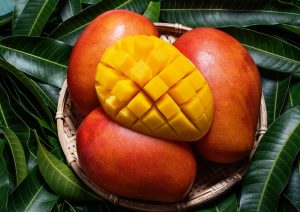
Mangoes have more than 20 vitamins and minerals and are great sources of vitamin A, C, fiber, potassium, and more. They may be good for your heart, eyes, digestive system, and immune system.
Mango is also extremely versatile and can be enjoyed on its own for a sweet snack or dessert, or can be easily added to salsas or chutneys, salads, or mixed in with other vegetables.
An entire mango offers about 70% of your daily recommended vitamin C serving, which helps beef up antioxidant support, immune function, and iron absorption. It is also packed with other antioxidants that help your body stand up to free radicals.
You’ll get about 3 grams of fiber in a whole mango, and slightly less if it’s sliced by the cupful. But either way, that’s a terrific serving that can help promote digestive and heart health.
Mango also features potassium and folate, which can both be beneficial to your heart.
If you’ve never had mango before, you’ll need a bit of a primer. First, select one that has a little give when you squeeze it, which means it is ripe and ready to be eaten. It should be a yellow/orange color.
You don’t want to bite right into it. It’s got a thick, bitter skin that is best avoided. There is also a big pit that runs the length of it, which can be another potential challenge to the untrained eater.
What you want to do is cut the mango in half, lengthwise, moving around the pit. Once it’s in half, take a knife and score each piece into little squares, still attached to the skin. Once you’ve done that, use your hands to pop the meat up, eating it directly off of the skin (like corn on the cob). You can get the meat by the pit, as well.
To put in a salad or salsa, follow the same directions but remove the skin after scoring.
Mango is a juicy, tropical, summertime superfruit that can contribute to a healthy diet. Be sure to include a variety of fruits this summer to get the most from the season.